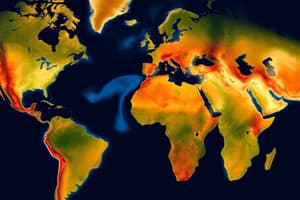Podcast
Questions and Answers
¿Cuál es la principal razón por la que el agua está mal distribuida en Perú?
¿Cuál es la principal razón por la que el agua está mal distribuida en Perú?
- El crecimiento urbano descontrolado. (correct)
- La escasez de recursos hídricos en zonas rurales.
- La falta de infraestructura adecuada en zonas costeras.
- Los cambios climáticos extremos. (correct)
¿Qué vertiente en Perú tiene el mayor desafío en la gestión del agua?
¿Qué vertiente en Perú tiene el mayor desafío en la gestión del agua?
- Vertiente de los Andes.
- Vertiente del Amazonas.
- Vertiente del Pacífico. (correct)
- Vertiente del Titicaca.
Seleccione cuál de las siguientes condiciones afecta negativamente la calidad del agua en Perú.
Seleccione cuál de las siguientes condiciones afecta negativamente la calidad del agua en Perú.
- Reforestación de zonas aledañas a ríos.
- Revolución tecnológica en el tratamiento del agua.
- Contaminación de fuentes hídricas por actividad industrial. (correct)
- Sobreexplotación de acuíferos en áreas rurales. (correct)
¿Cuál de las siguientes soluciones es más efectiva para mejorar la distribución del agua en las tres vertientes de Perú?
¿Cuál de las siguientes soluciones es más efectiva para mejorar la distribución del agua en las tres vertientes de Perú?
¿Cuál de las siguientes afirmaciones describe mejor la situación del agua en la vertiente amazónica de Perú?
¿Cuál de las siguientes afirmaciones describe mejor la situación del agua en la vertiente amazónica de Perú?
Flashcards
Problemas del agua
Problemas del agua
Cuestiones que afectan el acceso y calidad del agua en Perú.
Distribución del agua
Distribución del agua
Forma en que el agua se reparten diferentes regiones del Perú.
Vertientes hidrográficas
Vertientes hidrográficas
Zonas donde el agua fluye hacia un mismo río o lago en Perú.
Vertiente costera
Vertiente costera
Signup and view all the flashcards
Vertiente amazónica
Vertiente amazónica
Signup and view all the flashcards
Study Notes
Problems Affecting Water Distribution in Peru's Three River Basins
-
Peru's water resources, distributed across three major river basins (the Pacific, the Amazon, and the Andean), face numerous challenges stemming from climate change, human activities, and unequal access.
-
Climate Change Impacts: The increasing frequency and intensity of El Niño Southern Oscillation (ENSO) events significantly disrupt water availability. Droughts and floods are amplified, affecting water resources and agricultural practices. Prolonged droughts diminish water storage in reservoirs and rivers, impacting water supply and hydropower generation. Conversely, intense flooding can cause damage to infrastructure, contaminate water sources, and displace communities.
-
Deforestation and Land Use Change: Conversion of forested areas to agricultural land or for human settlement leads to reduced water infiltration and increased surface runoff. This, in turn, impacts river flow regimes, reduces water quality, and accelerates soil erosion, leading to sedimentation. Increased runoff exacerbates flooding risks in downstream areas. Unsustainable agricultural practices and poor irrigation techniques increase water consumption and reduce overall water availability.
-
Pollution and Contamination: Industrial and agricultural runoff, as well as sewage, contribute to water pollution, diminishing water quality. Nutrient pollution (eutrophication) from fertilizers can lead to algal blooms, which deplete oxygen levels, damaging aquatic ecosystems and harming human health. Mining activities often release heavy metals and other toxic substances into rivers, contaminating water resources. Improper waste disposal and lack of sanitation infrastructure further contribute to water contamination.
-
Unequal Access and Water Management Issues: The uneven distribution of water resources across different regions and socioeconomic groups creates significant inequities. Water access is often dependent on economic status, geographic location, and influence. Poorly managed water resources can lead to conflicts with regard to access, as well as agricultural production disputes. Lack of adequate infrastructure for water storage, treatment, and distribution hinders efficient water use and increases the risk of water scarcity during droughts.
-
Overexploitation of Water Resources: Increased demands for water from agriculture, industry, and domestic use frequently exceed the natural capacity of water sources. Irrigation techniques that don't consider efficient water usage further increase this problem. Extraction of groundwater for irrigation and industrial needs can lead to depletion of aquifers, lowering water tables and causing land subsidence.
-
Incomplete Infrastructure: Regions in Peru, particularly rural areas, may lack access to essential water infrastructure such as reliable water treatment and distribution systems. Poor infrastructure also increases vulnerability to waterborne illnesses and impacts public health.
-
Lack of Awareness and Education: Limited awareness and education campaigns regarding responsible water use among the population contribute to the issue. This lack of awareness hampers efforts to promote water conservation and sustainable water management practices.
-
Impact on Ecosystem: Degradation of water quality and quantity affects aquatic ecosystems, decreasing biodiversity and damaging wetlands. This has severe consequences for the ecological balance and the services that these environments provide, including flood control and water purification.
-
Impact on Human Health: Contaminated water sources pose significant risks to public health, increasing the incidence of waterborne diseases. This directly impacts vulnerable populations, especially children.
-
Transboundary Water Issues: Peru shares some river basins with neighboring countries, raising questions regarding water sharing agreements and cooperation. Transboundary water issues require collaborative efforts and effective water resource management strategies across borders to avoid conflicts.
Studying That Suits You
Use AI to generate personalized quizzes and flashcards to suit your learning preferences.




